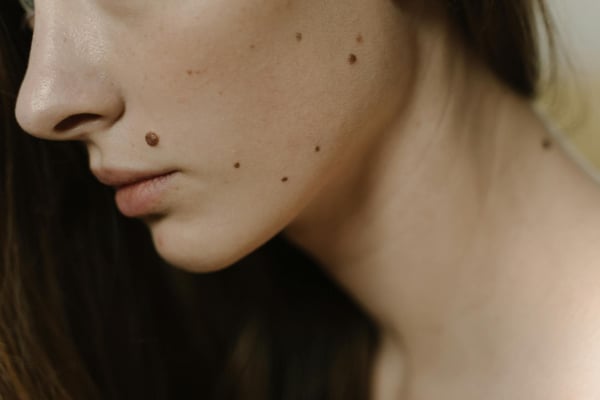
Back at the beginning of the pandemic, many people stuck at home turned to a risky activity that caught fire on social media: DIY skin mole removal. Some used apple cider vinegar, others tried shaving or waxing them, and others just ripped them off…but the results were not always favorable. It wasn’t long before the dangerous practice was condemned by medical professionals.
Also known as nevi, a mole is simply a common skin growth that can develop anywhere on your face or body. Moles are typically brown but can also be black, tan, pink, red or even blue, and some have hair growing from them. Moles can be caused by everything from genetics to sun exposure to hormonal changes (including pregnancy). While the average adult has around 30 to 40 moles, some people have hundreds.
Most skin moles are harmless but can be cancerous, so it’s important to monitor them for changes in size, color, and appearance. But even a harmless mole that stays the same for years can cause anxiety or discomfort — no one likes a mole that frequently gets snagged on clothing or jewelry.
So, can skin moles be removed? The good news is yes, they can absolutely be removed safely through several different methods.
Just leave this task to the professionals.
Beware of home treatments for skin moles
DIY is great, but when it comes to your health and your body, always proceed with caution. Many of the so-called home remedies for mole removal can be a waste of time and money and come with potential risks:
- They may not work: Whether it’s vinegar, garlic or some other natural substance, the scientific evidence is just not there to support their use in mole removal. You’re likely to spend a lot of time and effort without seeing the results you want.
- You could get an infection: Some home remedies can make it easier for bacteria to enter the wound, which could lead to an infection: redness, swelling, pain, and pus that can require additional medical treatment and antibiotics.
- Your skin could scar or become discolored: Some DIY methods and harsh chemicals can lead to scarring and changes in your skin pigmentation, some of which may be permanent.
- You may miss a crucial diagnosis: Removing a mole yourself may prevent you from recognizing the early signs of melanoma or other skin cancers.
- Chemical burns: Some popular online solutions involve the use of acidic or caustic substances, which can cause chemical burns, blistering, and even long-term scarring.
How can skin moles be removed professionally?
Your dermatologist can recommend a safe and effective treatment for skin mole removal and help you understand the different methods, how they work and their potential outcomes.
Surgical shave
A shave excision is commonly used to remove moles that protrude above the skin’s surface. Your doctor will use a small blade to shave the mole at or just below the skin level. Often used for noncancerous moles removed for cosmetic reasons, this method doesn’t require stitches or long healing times.
Scissor excision
This method uses curved scissors to cut around and under the mole. The procedure is quick and often used for small, non-cancerous moles.
Punch excision
Like a tiny cookie cutter, a small, circular tool is pressed into the skin to create a circular incision around the mole, which allows your dermatologist to remove the mole and its root. The incision is usually closed with stitches. This method is often used for both raised and flat moles.
Surgical excision
Similar to the other excisional methods, the entire mole is removed – this time with a surgical knife – and the wound is closed with stitches. This treatment for skin mole removal is usually done when the mole is suspected to be cancerous.
Cryotherapy
Liquid nitrogen is applied directly to the mole, which freezes it and allows it to eventually fall off. However, cryotherapy can result in possible scarring and discoloration of the area.
Mohs surgery
Used primarily for skin cancers, Mohs involves the precise removal of skin layers performed in stages to preserve as much skin as possible. Each layer is examined under a microscope after it’s removed until no cancer cells are detected.
Stay attentive and turn to the pros
While moles are typically nothing to worry about, you should always stay vigilant and watch them for changes. Use the ABCDE rule to monitor moles over time:
- Asymmetry: Check to see if one half of the mole doesn’t match the other half.
- Borders: Check for irregular, blurred, or notched edges.
- Color: Check for multiple colors or an uneven distribution of color.
- Diameter: Look for moles larger than a pencil eraser (about a quarter-inch).
- Evolving: Check to see if the mole changes in size, shape, color, or height, or if you begin to experience itching, bleeding, or crusting.
Also, be on the lookout for any sudden appearances of a new mole especially after age 30, as this can be a sign of melanoma. Itchy or painful moles should also be checked by a dermatologist.
If you’re ready to remove a mole, be sure to turn to a Forefront dermatologist, who can identify any suspicious skin moles, recommend the most appropriate removal methods, and provide expert follow-up care.
(Photo credit: cottonbro studio: https://www.pexels.com/photo/woman-face-with-spots-6568231/)





